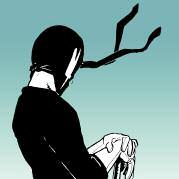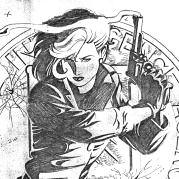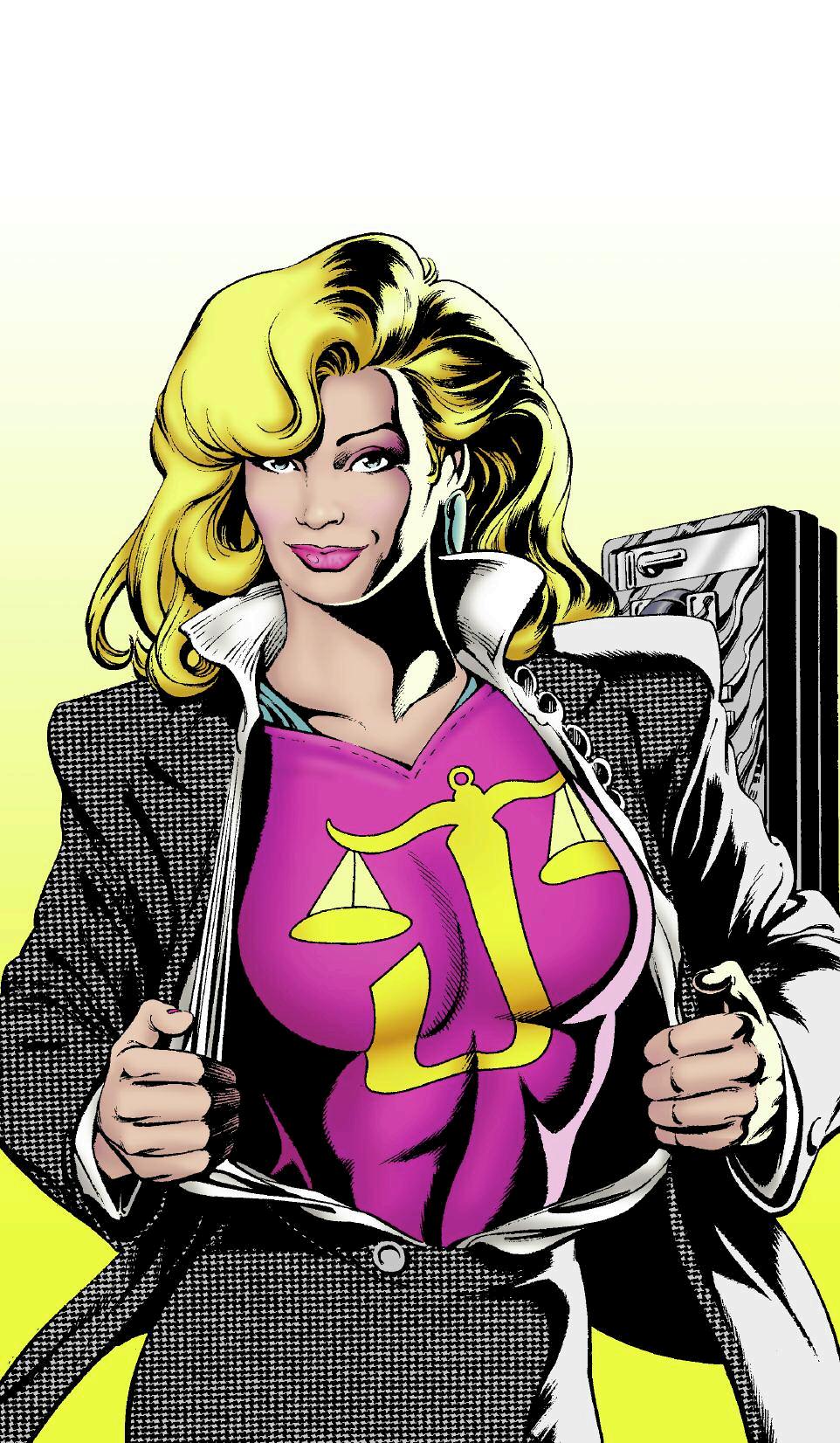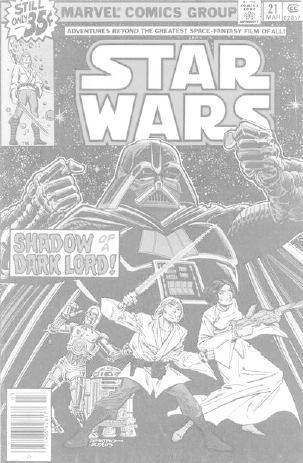the Comic Company The History of COMICO the Comic Company

No Day in the (Jurassic) Park
Things look bad for Gumby and Pokey in this rare promotional illustration by Arthur Adams. Drive, clay boy, drive! Gumby
Comico the Comic Company was the little publisher that could For a while, at least
In 1982, a trio of pals from art school Gerry Giovinco, Bill Cucinotta, and Phil LaSorda launched their own publishing company to nurture their creative itches. Their early black-and-white efforts (Slaughterman, Skrog, and Az) were primitive, but another art student they invited along on their venture, Matt Wagner, stood out among the pack. His character Grendel debuted in 1982’s Comico Primer #2, and today is still going strong at Dark Horse Comics
A d m i n i s t r a t i o n / m a r k e t i n g m o g u l B o b S c h r e c k jumped on board in late 1984, with editor in chief Diana Schutz following in early 1985 Cucinotta stepped aside and Giovinco took a less active role. Dennis LaSorda became co-publisher, his brother Phil ascending to executive officer. Meanwhile, Schreck and Schutz infused unbridled creativity and editorial professionalism into the company, and cultivated new talent like Tim Sale, Bill Willingham, Jill Thompson, and many others who have since gone on to wide acclaim. In 1987, Rick Taylor was hired as art director, exquisitely polishing the design of Comico’s comics
I became an editor there in January 1988, and assistant editor Shelly Roeberg (now Bond) joined the company later that year
T o t a l l y ‘ 8 0 s B A C K I S S U E 3
b y M i c h a e l E u r y
© 2004 Art
Clokey





Diana
Matt Wagner illustrated this announcement of Di and Bob’s October 1989 wedding Courtesy of Diana Schutz.


During the mid- to late 1980s, Comico took on commercial projects the popular anime series Robotech and two super-hero titles, Elementals and Justice Machine and released some of the most literate, dynamic, and just darn cool comics in the marketplace: Jonny Quest, Grendel, Mage, The Maze Agency, Gumby’s Summer (and Winter) Fun, The Rocketeer Adventure Magazine, and Rio, to name just a few. Top talent (Doug Wildey, Dave Stevens, Steve Rude, Mark Evanier, Gene Colan, and others) joined Comico’s groundbreaking newcomers, and the company earned industr y kudos. Abetted at different stages by Bob Pinaha, Maggie Brenner, Tim Ogline, Jeff Lang, Chuck Ragan, and a few others, Comico transformed from a low-budget, vanity-press outfit into a reputable, progressive publishing house.
Emphasis on the house. Marvel and DC are headquartered in Manhattan highrises, and most other publishers rent space from office complexes Comico, however, called a big, ghastly, three-stor y house its home (Dennis LaSorda operated his physical-therapy business from the first floor, with Comico commanding the rest of the building) The stairs creaked, the paint was chipped, the wallpaper was peeling, the toilets sputtered, the basement smelled, and the third-floor “offices” kids’ bedrooms in the house’s previous life were oppressively hot (one of them was mine, and during the sizzling summer of ’88, I wore bathing trunks to work each day and sweated off five pounds!). Keep this in mind while reading Diana Schutz’s references to “that horrible house” in this issue’s Wagner/Schutz “Pro2Pro” interview Its structural and decorating deficiencies aside, the Comico office was a wonderland of imagination, with Rick Taylor’s buoyant Pee-wee Herman impressions filling the hallways It was a fun place to work
There were setbacks along the way, of course Remember Max Headroom, the computer-generated ’80s TV sensation and Coca-Cola spokesman? Max was almost a Comico comic. Reveals Bob Schreck:
“Having rather cost-effectively negotiated the license to produce a Max Headroom comic book in 3-D (boy, was my good friend at Marvel Comics, Carol Kalish, jealous!), and having secured an approved script
p
i n a l British TV show) by Mike Baron, and then delivering the approved gorgeous pencil ar t from the Pander Bros., [all] before the character hit it big in the U.S., suddenly the U S licensor let Coke have their say and everything that was approved, s
y
e e
e
u d d e n l y w a s n o t T h e b o o k w a s d e a d N o r e f u n d , t h a n k y o u ! T h e c o r p o r a t i o n s q u a s h e d t h e computer-generated corporate-buster himself 4 B A C K I S S U E T o t a l l y ‘ 8 0 s
(
e r f e c t l
e d g y a n d i n k
p i n g w i t h t h
o r i g
Schutz and Bob Schreck
© 2004 Comico
© 2004 Comico
I was fresh off the comics-geek boat when I started editing at Comico in 1988 a n d h a d b e e n a f a n o f M i k e W B a r r ’s D C w o r k , s o b e i n g a s s i g n e d h i s n e w t i t l e , The Maze Agency , w a s q u i t e a t h r i l l

I t a l s o b e c a m e a v a l u a b l e l e a r n i n g e x p e r i e n c e . M i k e ’s p r o f e s s i o n a l i s m ( t h e m a n c o u l d n ’t m i s s a d e a d l i n e i f h e t r i e d ) a n d u l t r a - p o l i s h e d s c r i p t s t a u g h t m e a g r e a t d e a l a b o u t e d i t i n g a n d w r i t i n g I t w a s m y p l e a s u r e
w o r k i n g w i t h M i k e o n Ma ze , a n d I ’ m h a p p y t h a t t h i s i n t e r v i e w h a s a l l o w e d u s t o r e k i n d l e o u r f r i e n d s h i p A n o t h e r j o y o f The Maze Agenc y w a s t h e
“ d i s c o v e r y ” o f A d a m H u g h e s . A d a m h a d a f e w
p i n u p s a n d b l a c k - a n d - w h i t e s h o r t s t o r i e s u n d e r h i s
b e l t i n ’ 8 8 , b u t s h o w e d s u c h p r o m i s e , e v e r y o n e a t
C o m i c o k n e w h e w a s h e a d e d f o r g r e a t n e s s T h e f i r s t
time I met him in person, at a 1988 Comico portfolio
r e v i e w a t R i c h R a n k i n ’s c o m i c s s h o p , A d a m h a d
a l r e a d y b e e n h i r e d t o d r a w Maze , b u t p o l i t e l y
s t o o d i n t h e p o r t f o l i o l i n e t o m e e t h i s e d i t o r.
H e w a s n e r v o u s a n d s w e a t i n g p r o f u s e l y
( s o m e t h i n g I w o n ’t l e t h i m f o r g e t ) , b u t
I f o u n d h i s c o u r t e s y r e f r e s h i n g a n d
w h e n I r e c e n t l y s a w h i m a t t h e 2 0 0 3
S a n D i e g o C o m i c - C o n , h e ’ d g o t t e n
t h a t s w e a t i n g t h i n g u n d e r c o n t r o l !
The Maze Agency w a s a s p e c i a l s e r i e s f o r
a l l t h r e e o f u s D u r i n g o u r c h a t , M i k e , A d a m , a n d I
n a v i g a t e d a v i r t u a l m a z e o f m e m o r i e s a n d , l i k e g o o d
d e t e c t i v e s , r e c o n s t r u c t e d t h e h i s t o r y o f t h i s w o n d e r f u l
p r o j e c t Micha el Eur y
i n
T o t a l l y 8 0 s B A C K I S S U E 7
t e r v i e w
The A-Maze-ing Adam Hughes A rare Adam Hughes/Rick Magyar Maze Agency promotional piece for The Westfield Newsletter © 2004 Michael W Barr An interview by Michael Eury conducted on August 19, 2003, and transcribed by Brian K. Morris. Barr and Hughes revisit: Barr and Hughes revisit:
Super-Sleuth Team-Up
Barr’s Ellery Queen homage, from The Maze Agency #9.
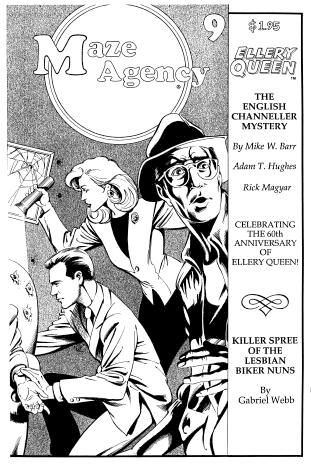
MICHAEL EURY: Let’s start with a flashback: 1988, Mike W. Barr, popular author of Camelot 3000, Batman and the Outsiders, and Detective Comics.
MIKE W BARR: Well, I wasn’t the author Because an “author” is someone like Frank Miller, who does the whole package, writing and art I’m a writer
ME: You got it “Writer ” Adam Hughes, you were a promising young artist at that time This was your first regular series
ADAM HUGHES: Yep, I was wearing long pants and ready to shave.
ME: (laughs) And yours truly, Michael Eury, a newly hired editor at a relatively small, but cutting-edge, comic-book publisher in the “metropolis” of Norristown, Pennsylvania. So, do we feel ancient yet?
MWB: Yes, I have for some time (laughs) It’s got nothing to do with this conversation, I assure you
M E : M i k e , i n c a s e a n y o n e re a d i n g t h i s i n t e r v i e w i s unfamiliar with The Maze Agency, why don’t you define the series?
MWB: Back in 1985, ’86, I’d wanted to do a creatorowned detective series By “detective series,” I mean in the sense that it would have actual mysteries, actual whodunits, which would be solvable by the reader if the reader was sharp enough to pay attention to the clues Based, of course, on my love of the classic detective stories of Ellery Queen Later, of course, I would pay homage to Queen by using Ellery Queen in Maze Agency #9
ME: And even though you were writing some super-hero comics with detective elements, you didn’t get to explore whodunits to that degree
MWB: Well, I did to some extent, about as much as I wanted to. But I felt that if you write Batman, you’re honor bound simply by the fact it’s Batman to have a certain amount of physical action in there. And I have no problem with that and I don’t regard that as any part of compromise, or a weakening of the material, if you’re
8 B A C K I S S U E T o t a l l y ‘ 8 0 s
Maze Agency © 2004 Michael W Barr
Queen is a TM of Manfred Lee and Frederic Dannay
The
Ellery
DS: I know it seems like it’s far away, but, man, don’t blink
ME: It’s a testament to your talent and to your creations that you’re able to celebrate a twenty-fifth anniversary when you think of the other comics that premiered alongside you during the early- to mid-’80s Hardly any of them have withstood the test of time
MW: Yeah, true, true. I am one of the last men standing. (laughs)
DS: So, like, dude, what about Mage III? (laughs)
MW: I don’t know I know how it starts (laughs) I know what song it begins with (laughs)
ME: What’s new in Dydie’s den? What are you excited about?
D S : A u t o b i o G r a p h i x , w h i c h w i l l b e o u t i n N o v e m b e r [now available from Dark Horse Comics].
ME: Featuring the work of. . . ?
MW: Creators not known for autobiographical comics
D S : A c t u a l l y, i t ’s a s t r a i g h t r i p - o f f o f w e l l , i t ’s n o t a straight rip-off, but TwoMorrows had a very good idea a few years back. They did an anthology called Streetwise.
ME: Wonderful book.
D S : A n d t h e y g o t a b u n c h o f p r i m a r i l y m a i n s t r e a m c a r t o o n i s t s to write and draw autobiographical stories, and it was very cool, and I really enjoyed it But it was a big, giant thing and I like the idea of something smaller and therefore, a little more intimate, with more of an indy focus and a little less adventure-oriented, I guess (to Matt) What?
MW: I was going to comment, it’s so funny, it’s almost a metaphor for the exact same thing as the independent publishers in the ‘80s, thinking they had to go to newsstand when in fact, they should have remained smaller and intimate Think of how many people back then went, (growls) “I want my books big I want ‘em really big!” And now, it’s like everybody wants to go small now (laughs)
DS: Well, first of all and I’ve been saying this for years

“He’s the strangest, smartest foe Batman has ever
faced. . . ”
A killer page from the two-issue, Prestige Format Batman/Grendel series produced by Wagner in 1993.
the pamphlet is dead, the thirty-two page pamphlet That roll-it-up-and-stick-it-in-your-back-pocket-thing?
I t ’s o u t - p r i c i n g i t s e l f I t j u s t d o e s n ’t w o r k a n y m o r e
Whereas the bookstore market is continuing to blossom for us, with books like Craig Thompson’s Blankets proving that going straight to books is really where a growing market is for us. It’s perennial publication where the growth is now, rather than periodical publication
MW: So you talk about verification
DS: Yes
MW: that’s your verification
DS: Yeah
MW: See, we are books, we are literature We’re not something you can roll up and stick in your pocket The
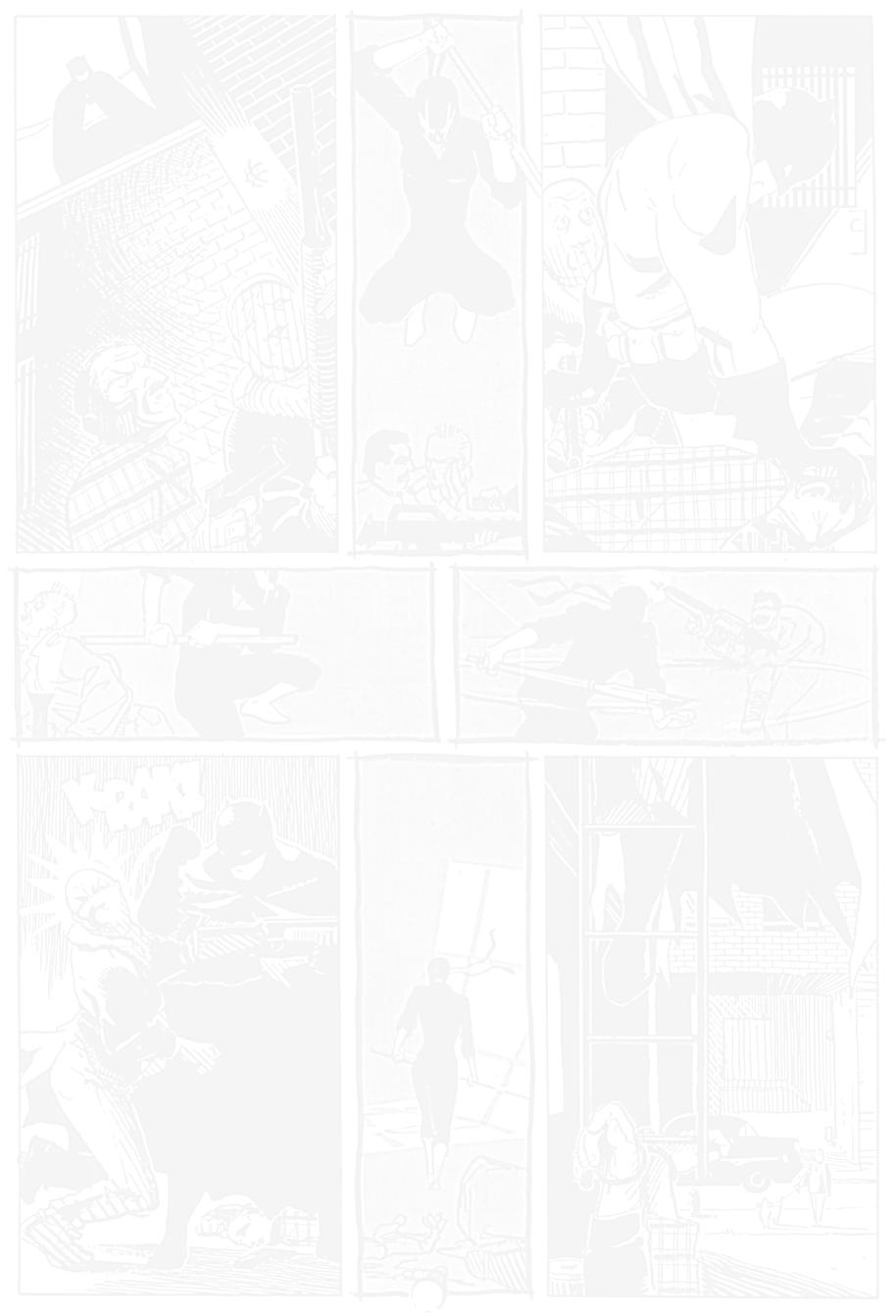

T o t a l y 8 0 s B A C K I S S U E 4 3
Batman © 2004 DC Comics Grendel © 2004 Matt Wagner
Still Available TwoMorrows Publishing’s
Award-winning Streetwise features autobiographical comics stories by top creators See the ad elsewhere in this issue. end
Original’s
Eisner
“I loved the executioner’s style mask,” recalls Steve Rude of his childhood impression of Space Ghost Courtesy of the artist
© 2004 Cartoon Network
I n e v e r t h o u g h t I ’ d c o n s i d e r Wo r l d ’s F i n e s t d r a w n b y S t e v e Rude to be bad news. But when “the Dude” (one of my favorite artists) told me, back in late 1988, that he had committed to pencil a DC Comics miniseries starring Superman and Batman (two of my favorite heroes), the news was sobering
At the time, as an editor at Comico the Comic Company, I was tapped by editor in chief Diana Schutz to shepherd the sequel to Comico’s successful 1987 Space Ghost one-shot The Space Ghost comic, in case you missed it (if you did, hit the back-issue bins or eBay now!), wonderfully recreated the atmosphere of CBS-TV’s Space Ghost not the diluted TV version that appeared on NBC’s Space-Stars in 1981, or the easily agitated talk-show host played for laughs on the Cartoon Network’s Space Ghost Coast to Coast, but the Alex Toth-designed super-hero whose Saturdaymorning cartoon ran from 1966 through 1968
While mildly seasoned with humor (usually through the comic-relief character Blip the monkey), the original Space Ghost program was replete with action. Forget t h e l o o n i e s o n C o a s t t o C o a s t S p a c e G h o s t ’s r e d o u b t a b l e r o g u e s ’ g a l l e r y t o o k tremendous steps to try to destroy their nemesis. The Comico comic’s splash page so flawlessly mimicked the animated series’ title frame it brought to mind the eerie Space Ghost TV theme, and painter Ken Steacy’s palette gave each panel the look of an animation cel. Being an ardent fan of Hanna-Barbera cartoons (DNA tests have proven that I am a direct descendent of Joe Rockhead, a Water Buffalo lodge buddy of Fred Flintstone’s), the prospect of editing Space Ghost II was incredibly exciting.
Steve Rude’s love of Space Ghost far exceeds mine. Anyone who has the pleasure of knowing him is aware that the Dude, as a little dude in 1966, was captivated by the Space Ghost TV show. “Space Ghost was serious drama for me,” Steve remembers. “He was strong and powerful I loved the executioner’s style mask The posing of his body was cool I’ve always responded to things like that, much in the same way that Jack Kirby’s characters always had cool poses to them.” Another aspect of the show that impressed the Dude was its soundtrack: “The music was driving and powerful. If the music wasn’t like that, it would have been like sprinkling water over a blazing fire I often think about just how i m p o r t a n t m u s i c a n d a l l t h o s e b
S p a c e G h o s t a n d T h e H e r c u l o i d s –NOT in one
Together!
S p a c e G h o s t a n d T h e H e r c u l o i d s –NOT in one Comic
Together! S p a c e G h o s t © 2 0 0 4 C a r t o o n N e t w o r k
Your Two Favorite Cartoon Shows-
Comic Book
Your Two Favorite Cartoon Shows-
Book
i
h a e l E u r y 4 4 B A C K I S S U E T o t a l l y 8 0 s
y M
c
other things, down to instinctively perfect timing is to a show. Some shows just s e e m t o h a v e a l l t h o s e t h i n g s l i n e d u p i n a p e r f e c t w a y ”
Drawing Space Ghost was the realization of a dream for fan-favorite Rude, and the comic’s success was largely the result of his artwork. The concept of a Space Ghost sequel hinged upon the Dude’s participation, and Steve was happy to do it
For the second installment, Rude assumed a larger role in the writing process Regarding Mark Evanier, who scripted the first Space Ghost, Steve contends, “I don’t think Mark quite ‘got’ the show the way I did On the first book, I had sent Mark videotapes of Space Ghost, and my impression is that after he watched them, he simply reacted to the surface things and just set about his professional duty in writing a script Mark is older than I am and was probably moving onto other things when Space Ghost came on in ‘66. Mark has turned out some stunning work in the books we’ve done together, but I think deep down, he’s much more comfortable doing books that are more humor than serious drama.”
Animation writer/designer Darrell McNeil kept no secret from Rude his desire to be involved with Space Ghost II “Darrell was always making such a pest of himself back then,” Rude jokes, “he kind of weaseled his way into the development of the second issue ” Rude and McNeil brainstormed some ideas, and Rude typed a four-page, single-spaced first draft of the plot, titled “The Trial,” dated Sunday, January 31, 1988 An accompanying fifth page provided the Dude’s recommendations to his writing partner on how to best capture the voices of Space Ghost and his foe, Black Widow (in reading some of the dialogue, I imagined voice actor Gary Owens reciting the lines, a testament to their accuracy) After plot discussions and a February 21, 1988 list of revisions, McNeil helped expand Rude’s story into a double-spaced, 12 1/2-page detailed outline.
“ T h e Tr i a l ” r e s u m e s
i m m e d i a t e l y a f t e r t h e
c o n c l u s i o n o f “The Sinister Spectre” (Comico’s first Space Ghost stor y), with Space Ghost, teen twins
Jan a n d J a c e , a n d B l i p
r e t u r n i n g h o m e t o
G h o s t P l a n e t i n t h e star-spanning Phantom
C r u i s e r T h e i n s i d i o u s
S a n d m a n i s l u r k i n g i n

A “Strong and Powerful” Pose
A 1994 convention sketch by the Dude Courtesy of the artist.
© 2004 Cartoon Network
e r c u l o i d s © 2 0 0 4 C a r t o o n N e t w o r k
H
T o t a l l y ‘ 8 0 s B A C K I S S U E 4 5
One Big Battling Family
R u d e i l l u s t r a t e d t h i s H e rc u l o i d s c o v e r f o r D C C o m i c s ’ C a r t o o n N e t w o r k P r e s e n t s # 1 7 I n t h e i n s e t , n o t e t h a t t h e D u d e ’s a r t was flopped for the comics cover.
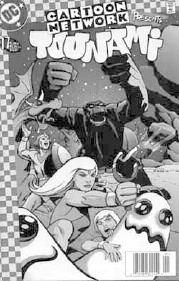

the shadows, and disables the group with his patented sleep mist. Sandman’s Sandmen kidnap Space Ghost, leaving his young allies behind
Space Ghost awakens and finds himself on the planet Anarch, bound before a bizarre jury consisting of three of his most incorrigible nemeses: Zorgat (ruler of the Rock Robots), the Schemer, and Moltar (of the Molten Men). With the venomous Black Widow as judge, the sinister Sandman as p r o s e c u t i n g a t t o r n e y, a n d a m y s t e r i o u s o v e r s e e r c a l l e d t h e L a w g i v e r orchestrating the affair, Space Ghost is charged with “crimes against evil ” His felonies vanquishing the juror-villains in reenactments of scenes from the actual Space Ghost TV episodes in which they appeared are replayed before the jury, and Space Ghost is, not surprisingly, found guilty He is sentenced to “re-fight” these battles again, being “guaranteed” his freedom should he succeed. Meanwhile, Jace, Jan, and Blip regain consciousness and take to the spaceways in the Phantom Cruiser, locking onto Space Ghost’s coordinates and tracking him to Anarch
The stor y progresses at a brisk pace, with Space Ghost teleported to remote worlds for rematches, first with a trio of Rock Robots, then with the mountainous automaton Titanor Despite the odds being unfairly stacked against him, Space Ghost proves victorious, to the surprise of his f o e s . J a n a n d J a c e a r r i v e o n A n a rc h b u t a r e a p p r e h e n de d , w i t h B l i p undetected thanks to a cloak of invisibility
For Space Ghost’s final battle, the hero and his young friends are sent to the homeworld of the Herculoids patriarch Zandor, his wife Tara, their son Dorno, the gelatinous shapeshifters Gleep and Gloop, the rock-gorilla Igoo, the flying space-dragon Zok, and the armored dinosaur Tundro.
Since Space Ghost and the Herculoids are allies (from previous animated cartoons), the enigmatic Lawgiver emits “illusion rays” that cause the Herculoids to see, instead of our heroes, three of their most bitter adversaries: they believe Space Ghost to be Prokar, lord of the Beaked People; Jan to be Queen Skorra; and Jace to be the Bubblemen’s leader, Brotak.
The stor y explodes into a spectacular battle (use your imagination to picture what the Dude could have d o n e w i t h t h i s c o n f l i c t ) , w i t h S p a c e G h o s t a n d c r e w a t a d i s a d v a n t a g e , p u z z l e d o v e r t h e i r f r i e n d s ’ a t t a c k a n d t h u s l y h o l d i n g b a c k t h e i r m i g h t . S p a c e G h o s t u l t i m a t e l y s u r m i s e s t h a t t h e H e rc u l o i d s a r e o p e r a t i n g u n d e r a case of mistaken identity and uses his power bands to create a force field to block the Lawgiver’s mind-altering rays. The heroes make amends, just in time for Blip, on Anarch, to materialize and teleport all the heroes to the jury room! Space Ghost, Jan and Jace, and the Herculoids overpower the villains, and the Lawgiver is revealed to be One-Eye, the mousey assistant to Space Ghost-foe the Lurker Space Ghost gives the Herculoids a tow home, and the stor y concludes with the hero belting out his eternal cr y, “SP-A-A-A-C-E GH-O-O-O-OST!”
4 6 B A C K I S S U E T o t a l l y 8 0 s
© 2004 Cartoon Network
Granted, the plot to “The Trial” is relatively simple, but then again, so was the Space Ghost cartoon. During these days before Space Ghost Coast to Coast, Hanna-Barbera cared little about the property and posed no interference with the story The plot was approved, and while I edited away on my other books, I anxiously awaited the day the Dude would begin Space Ghost II.
And then I got the call
Steve was polite and diplomatic, and noted that after the smaller-scale labors of love Space Ghost and First Comics’ Nexus, he felt it was necessary to take on a commercial project like World’s Finest I couldn’t argue with his logic. Comico obtained from Hanna-Barbera a Space Ghost contract extension, and everyone assumed that sometime in 1989, whenever Rude’s Superman/Batman miniseries was completed, he’d return to Ghost Planet, rarin’ to go.
Then, in February 1989, Comico began its freefall to implosion and dissolution (see this issue’s lead article and the Mike W Barr/Adam Hughes “Pro2Pro” interview for details) The publisher went belly up, the Dude moved on to other projects, and in a few short years, the ghostly hero had been reinvented as the snappy Coast to Coast host
Fast for ward to the fall of 2003 As I was brainstorming projects for this column and realized that most readers would not even be aware that a Space Ghost sequel was planned, my next thought was, W h y d i d n ’t t h e D u d e t a k e t h e p r o j e c t t o D C , o r t o a n o t h e r p u b l i s h e r ? So I asked him His reply: “I have never felt comfortable ‘lobbying’ for projects People in the business know my rep for taking my work seriously, and if they’re on the same page with me creatively, then it’s usually just something that falls into place My life back then was Nexus, and anything else that came around was a nice bonus. But doing the first Space Ghost special was clearly something I had to do ”
I n c a s e y o u ’ r e w o n d e r i n g i f R u d e r e g a r d s S p a c e G h o s t I I a s a n u n f i n i s h e d s y m p h o n y, the artist comments, “Not really. The madness seemed to leave me once I did the first Space Ghost book Besides, Nexus was my version of Space Ghost In the mid-1990s, when Hanna-Barbera got a full-time staff of licensing people, they contacted me about doing some new books But instead, I merely recommended a new up-and-coming artist [to draw Space Ghost], which he did, and was very happy about. That was also the time I was doing my own version of Space Ghost-type animation, which was the Nexus animated promo ”
Rude’s Nexus cartoon trailer premiered to a cheering, standing-room-only crowd at the 2003 San Diego Comic-Con. At this writing, however, Nexus has not yet made it onto television To keep abreast of its progress, and of the Dude’s latest and forthcoming projects (including The Moth, above right, coming from Dark Horse Comics), visit his site at www steverude com
But as for the unrealized Space Ghost II, that, alas, remains a greatest stor y never told
NEXT ISSUE: Plastic Man has twice been unsuccessfully developed as a live-action movie. For the scoop, be here next issue.


Buzzing Your Way
The Dude’s new creation (with co-writer/inker Gary Martin), The Moth, is debuting in March from Dark Horse Comics.

The Galaxy’s Ghostly Guardian

Another majestic pose of Space Ghost, courtesy of the artist.
© 2004 Cartoon Network
© 2 0 0 4 S t e v e R u d e T o t a l l y ‘ 8 0 s B A C K I S S U E 4 7
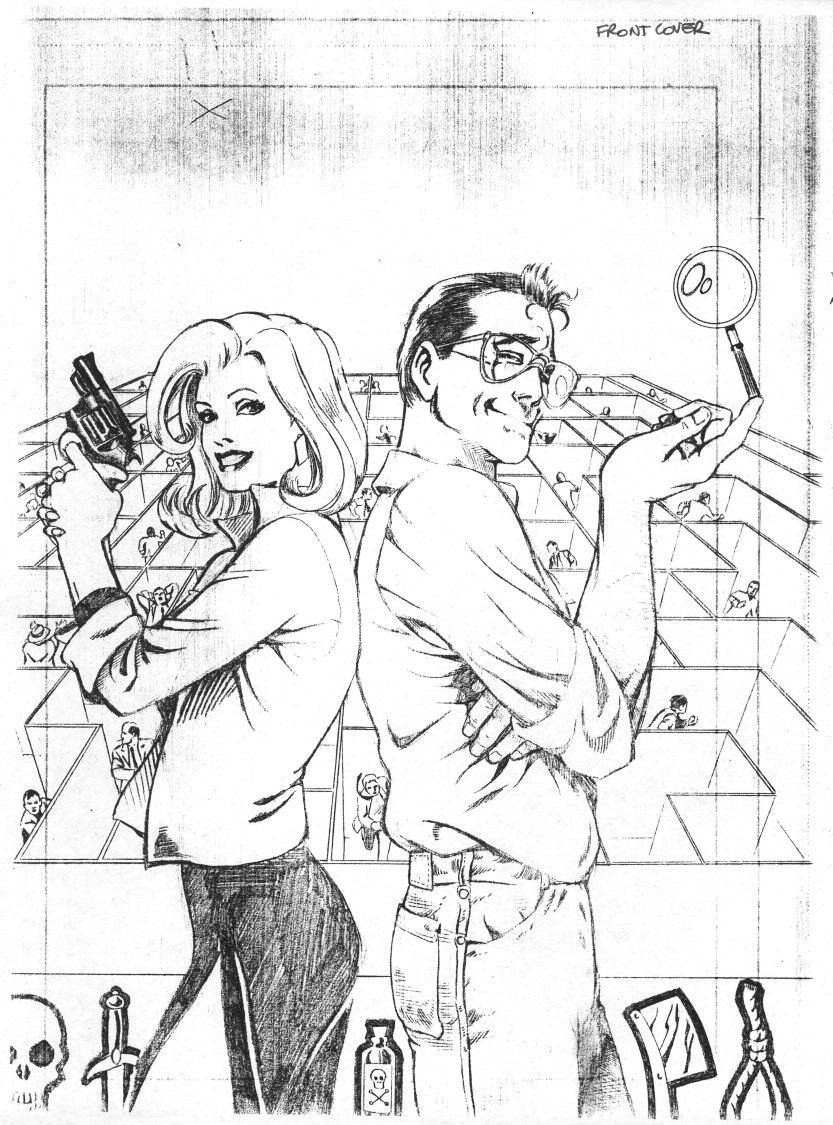
Michael Eury (special thanks to Adam Hughes, Mike W. Barr, and Wally Harrington)


“I wanted to be more of a pinup artist, ” Adam Hughes told Mike W. Barr, writer of The Maze Agency, and me, their editor, in this issue’s lead “Pro2Pro” interview. At this early stage of his career, Adam showed he could deliver the goods.
t i m e l i n e s
H u g h e s ’ c o v e r r o u g h a n d t h e f i n i s h e d p r o d u c t , w i t h R i c k M a g y a r s’ i n k s .
y
M A Z E A G E N C Y # 1 • 1 9 8 8 feature © 2 0 0 4 M i c h a e W B a r r 4 8 B A C K I S S U E T o t a l l y 8 0 s
b



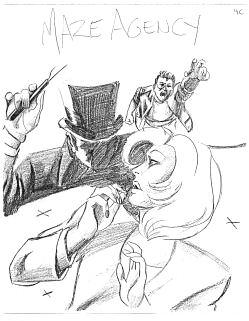

Adam submitted three variations on the “return of Jack the Ripper” theme for this issue of Maze. Each created a sense of depth—plus just enough suspense and sex to lure the reader to the interior contents—but version A had the most impact
t i m e l i n e s N o t e A d a m s’ c h a n g e s b e t w e e n t h e f i r s t c o v e r r o u g h a n d t h e f i n a l p e n c i l e d v e r s i o n . V e r s i o n C w a s u s e d a s t h e b a c k c o v e r t o M a z e A g e n c y # 2 .
M A Z E A G E N C Y # 4 • 1 9 8 9 © 2 0 0 4 M i c h a e l W B a r r T o t a l l y ‘ 8 0 s B A C K I S S U E 4 9




GO WEST, YOUNG MAN (AND WOMAN)
In the early 1980s, Bruce Jones took a cue from 1950s comics and gave readers an old idea anthology books but delivered them with a new jolt of creativity and skill (and graphic violence and sex, too). The results were Twisted Tales and Alien Worlds
The genesis of these books came when Bruce met his wife, April Campbell Their meeting occurred at a time when Bruce was considering heading to California from the Midwest; both were interested in exploring prospects in film and television
At the same time, Steve and Bill Schanes were starting up Pacific Comics in San Diego When Steve Schanes invited Bruce to do some books for the company, Bruce saw this as a good chance to make the move to the West Coast Twisted Tales #1, cover dated November 1982, hit the stands with a cover (and interior story) by none other than Richard Corben. Getting an artist of Corben’s caliber was a major coup and it helped establish Bruce’s books in terms of quality “Corben, [Bernie] Wrightson, and [Russ] Heath all helped make me a name at Warren [Publishing], and I wanted them on my books both to pay them back for helping me early in my career and because they were all wonderful artists and good friends,” Bruce tells BACK ISSUE “It was very hard to get this premium talent, because everybody wanted them and they were always booked months in advance I think I only got them because of our friendship, not because they really needed the work It was an extremely fortuitous time, the likes of which I doubt we’ll ever see again. The only thing I can compare it to would be the Warren days, perhaps. So much great talent crowded into too few years But it was gold while it lasted ” Jones followed up his horror title with the science-fiction series Alien Worlds The first stor y was by Al Williamson, a lucky move on the part of Bruce given Williamson’s stature and the name he had made for himself at EC Comics Bruce is the first to agree that Williamson is a master of his craft: “Al and I go way back,

Bruce Jones and April Campbell
Ken Steacy was nice enough t o s e n d t h i s p h o t o o f h i s f a v o r i t e a u t h o r / e d i t o r t a g - team, Bruce and April, taken a t t h e 1 9 8 3 S a n D i e g o Comic-Con, around the time Twisted Tales and Alien Worlds were on the stands
feature
y D a n J o h n s o n
b
6 0 B A C K I S S U E T o t a l l y ‘ 8 0 s
Twisted Siste
The character Miss Delgado in Corben “Infected” (Twisted Tales #1) wa modeled after April Campbell
You Can’t Spell “Implosion” Without “I”: A Bottom-Rung View of One of DC Comics’ Darkest Hours







































It was in late June of 1978 when DC Comics editor Jack C. Harris entered my office and closed the door. Jack thrust out his right hand and I automatically rose and shook it, without knowing the occasion
“Congratulations,” Jack said, “we get to stay ”
I had met Jack when I had begun work at DC in September of the previous year, and though we weren’t close friends, we shared several enthusiasms such as DC Silver Age comics I had even done a little writing for him Though I saw a lot of Jack every day his office was right next to mine as DC proofreader and general man-of-all-work for him to close the door before he spoke was both unique and a trifle ominous; now I knew why.
Editor’s note: Mike W. Barr is best known in the world of comics as the author of such landmark series as Detective Comics, Camelot 3000, Batman and the Outsiders, and the subject of one of this issue’s “Pro2Pro” inter views, The Maze Agency. But did you know that Barr started his comic-book career in the late 1970s as the DC Comics proofreader? He has an interesting perspective on the infamous DC Implosion that he’d like to get off his chest
I had known as had the entire office that Something Was Up. Rumors had drifted down that the higher-ups of Warner Communications, Inc , DC’s parent firm, were unhappy with DC’s performance and were determined to take further action
“The most extreme story had DC shutting down publication of all original comics immediately, keeping only the “big three” titles of Superman, Batman, and Wonder Woman alive as reprint books to keep a newsstand presence and merchandising interest alive.”
Like their initial action wasn’t severe enough: DC’s plan to increase the price of many of their monthly titles to 50¢ (from 35¢) with an increase of story pages to 25 the much-ballyhooed “DC Explosion” had had the rug pulled out from under it by corporate heads at Warner Communications after only three months An excellent report in The Comic Reader #159, August 1978, said that the Warner execs had wanted to sell more comics (and who didn’t?) by methods involving an overhaul of the distribution system. The Warner execs felt DC’s comics stood a better chance of going head-to-head with their competitors (read: Marvel) if DC’s books more closely approached the price point and physical package offered by Marvel DC’s production immediately dropped from 32 books a month to 23, a drop of almost 40%. However, some titles, released in the experimental “Dollar Comics” format, did well, so that format was kept for some existing books Of course, much of the cancelled material saw print in DC’s in-house publication, Cancelled Comics
– Mike W. Barr
g
u e s t e d i t o r i a l b y m i k e w . b a r r
7 2 B A C K I S S U E T o t a l l y ‘ 8 0 s

Cavalcade, more about which in the companio article. (What methods, if any, were taken to “overhaul the distribution system” remain unknown to me, and seem a proper subject for an article by an informed person. The DC titles affected by the Implosion wer returned to 17 pages of editorial content, ye a price increase of 40¢, from 35¢, a high hurdl for even improved distribution to take.)
So Warner execs none of whom had to w about their incomes being reduced had alr slashed DC’s output from 32 books a month t yet it was rumored further action would be t though what form that action would take, n yet knew The most extreme story had DC sh down publication of all original comics imme k e e p i n g o n l y t h e “ b i g t h r e e ” t i t l e s o f S u p e r Batman, and Wonder Woman alive as reprint to keep a newsstand presence and merchand interest alive. None of us quite bought that, degree of our worry could be measured by th that none of us categorically ruled it out, either

When the Implosion fell, I and other DC staffers were given a list of freelancers whose assignments had just been cancelled with orders to tell them to stop work immediately Even I knew that was nothing more than a signal to a freelancer to pull an all-nighter to finish the assignment before delivery Amazing how many freelancers I contacted had finished the jobs they were working on just before I told them to quit
But. . . “We get to stay”? I hadn’t known things were that bad. Few people had. The mood at the office in the days immediately preceding what
DC Heroes Get the Boot
Sadly, many editors, writers, and artists did, too.
©
2004 DC Comics T o t a l l y 8 0 s B A C K I S S U E 7 3


No Ray of Sunshine
Barr lost his “Ray” writing assignment due to the Implosion’s axe. Plot by Barr, script by Roger McKenzie, art by John Fuller and Bob Wiacek.
© 2004 DC Comics
become known as
“ D C I m p l o s i o n ” ugh never loudly, never within hearing y D C e x e c u t i v e s ) d the work of comics sual, to say the least ly all the freelancers most of the staffers that comics were a ion in their careers, ary stop on the way things I was naively to be in comics, even orbit I had attained, aken a job in which
I u t i l i z e d m y B a c h e l o r o f A r t s degree to scrub floors at an Ohio Sears and Roebuck. I vividly recall conversations w i t h L e n We i n a n d M a r v i n Wo l f m a n ( t h e l a t t e r o f w h o m w a s i n t h o s e d a y s f r e e l a n c i n g a t M a r v e l , but was up at DC a lot), who asked me pointblank why was I glad to be in comics “We are in a dying business,” intoned Len. “Don’t y o u k n o w t h a t ? ” a s k e d M a r v i n .
I f w e a re i n a d y i n g b u s i n e s s , I thought, one of the reasons is because the books are so damn bad “Okay,” I said, “why are you still here?”
“If we are in a dying business, I thought, one of the reasons is because the books are so damn bad.”
– Mike W. Barr
“Oh, we’re not going to be in comics much longer,” Len replied. “No, we’re going to move to Hollywood and write The Love Boat, ” said Marvin Most (though by no means all) other comics pros would voice similar career goals at the drop of a cowl at least, until June of 1978
7 4 B A C K I S S U E T o t a l l y ‘ 8 0 s
Even though I still had a job, others weren’t so fortunate. Editors Al Milgrom and Larry Hama were s u m m a r i l y d i s m i s s e d , i n k e e p i n g w i t h t h e l o n gstanding business policy of “last hired, first fired.”
O t h e r p e r s o n n e l w e r e “ l e t g o ” a s w e l l , i n c l u d i n g some production workers Since these layoffs happene i n l a t e J u n e a n d e a r l y J u l y, w i t h t h e c a n c e l l a t i o n announced on June 22, 1978, office wags dubbed the actions the “Summer Solstice Massacre,” though th tag “DC Implosion” proved more enduring
I thought for awhile that my job was on the line t but I soon realized that my meager wages ($100 a w at first, then skyrocketing to $125) would barely ma dent in DC’s fortunes one way or the other, and I too “valuable” as a pair of all-purpose hands to be off A couple of office temps, Gaff (not to be mist for longtime DC contributor Carl Gafford) and Carlos had been hired to do the gofer work such as deliveries and retrieving the lunches of publisher Jenette Kahn, but it was apparently decided I could shoulder those burdens as well as my regular tasks of doing copying for the editors, and proofreading each and every page of comics DC published after all, their output was about to drop from 32 to 23 titles a month, so it was assumed I’d have the time For $125 a week, I w a s a b a r g a i n ! I
b u t I w a s n ’t f o o l ing myself.

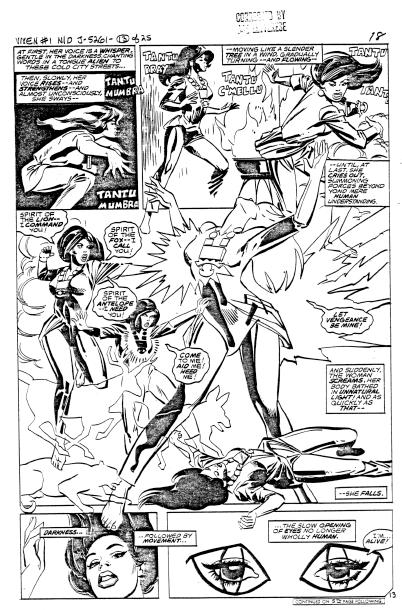
Fox Trapped!
Gerry Conway’s
The Vixen was another victim of the DC Implosion Pencils from DC’s Cancelled Comic Calvacade. ©
Nor was I complaining at least, not out loud I had pulled up stakes and moved to New York the previous September and had no prospects whatsoever should the DC job fall through. My long-range desire was to become a full-time freelance comics writer, but with DC canceling approximately 40% of its output, a lot of far better-established pros would be knocking on the doors of Marvel, Western, and Warren far more loudly than I could
Not long after there was a meeting of the entire DC staff to officially explain the new world to us. Nowadays a hall would have to be hired for such an assemblage, with DC’s staff numbering in the hundreds, but a quarter of a century ago when DC’s staff barely numbered over thirty it was possible, within the course of a regular workday, to say hello to everyone on staff. And that task had just become even easier
We were informed, at this meeting, that virtually all staff freelancing would come to a halt, save for those who had their output secured contractually. DC would need all its pages, we were told, for the freelancers who had contracts, and
w a s g r a t e f u l f o r t h e c o n t i n u e d e m p l o y m e n t ,
T o t a l l y 8 0 s B A C K I S S U E 7 5
2004 DC Comics




































A Retro-Review of the Industry’s Most Famous Comic You’ve Never Read
As the only actual contributor to Cancelled Comic Cavalcade (CCC) to ever write about it (I dialogued an eight-page “Ray” story, slated for Black Lightning #12, from a plot by Roger McKenzie, most famous as Frank Miller’s first collaborator on Daredevil), and maybe the only guy who has ever read each and every page of it (as the DC staff proofreader), you may think I have some special insight, some pearl of wisdom that will put it all in perspective for you.
Don’t kid yourself.



The basic fact is that CCC is the worst comic book that has had the best press of any comic book, ever Published solely to obtain copyright for hundreds of pages of comic books cancelled in the “DC Implosion,” CCC has for years had the daring reputation of a book that has been “censored,” and, with the human curiosity for what is deemed the forbidden, has therefore become an object of much curiosity and undue veneration. The Overstreet Price Guide for 2002 reports that “a #2 set sold in 2001 for $800 ” What remains unreported are the remarks of the purchaser after he read his acquisition, though they could probably be represented by the venerable cartoonists’ icons of winged dollar bills flying out a window and punctuation signs standing in for NC-17 words.
The majority of the stories collected in Cancelled Comic Cavalcade were generated in the days when DC Comics’ editorial standards were arguably the lowest of the firm’s existence The only company-wide editorial philosophy held by DC in those days was known as “the warm body theory” if a body was warm, it could work for DC Though a few gems exist among that rocky soil among them a still-unpublished Creeper story by the character’s creator, Steve Ditko; Ditko’s typically unique take on a costumed hero, the Odd Man, which was published with editorial “improvements” in Detective Comics #487; and a few covers everything else collected in CCC that was worth reading has been published in the intervening years, not that that’s a lot of pages And the stuff that hasn’t been, almost certainly doesn’t deserve to be (And I’m speaking as a contributor ) The material probably never should have been bought in the first place
You can take that from maybe the only guy who has read each and every page of Cancelled Comic Cavalcade, and certainly the only guy who has ever been paid to read them. Believe me, if you read them, you’d rather have those hours of your life back, too.



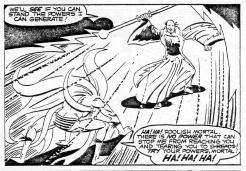
T o t a l l y 8 0 s B A C K I S S U E 8 3
Editor’s Note: The comments in this “Off My Chest” guest editorial do not necessarily reflect the opinions of BACK ISSUE magazine or of TwoMorrows Publishing end
currently available
all major
Star Trek © 2004 Paramount
s p e c i a l f e a t u r e CCC? No! CCC? No!
y M i k e W . B a r r
Mike W. Barr’s 2003 novel, Star Trek: Gemini, is
at
bookstore chains
Pictures
b
